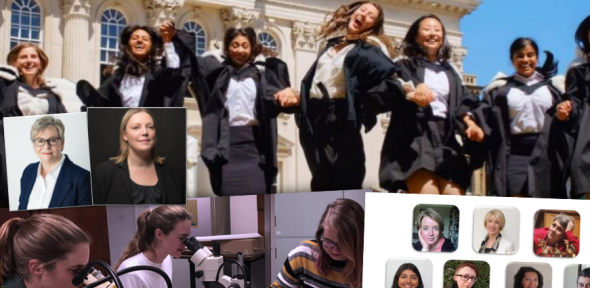
Talks, panel discussions and networking events are taking place across the University and colleges to mark International Women’s Day 2022, including events at the Museum of Zoology and the Institute of Astronomy.
The Women’s Staff Network (WSN) is celebrating by hosting a discussion with Pro-Vice Chancellor, Professor Kamal Munir to discuss the working lives of women at the University, where things are going well and where improvements can be made. The WSN is also co-hosting a panel discussion, ‘Gender Equality, Cambridge and Me!’, involving members from a number of diversity networks, the University’s Gender Equality Champions and the Equality, Diversity and Inclusion team.
Jenny Rampling, Chair of the University of Cambridge Women’s Staff Network, said: “International Women’s Day (IWD) provides an opportunity to highlight the many extraordinary women amongst our staff, students and alumni, who continue to push for equality in all its forms. However, it is also a call to action as we still have a significant gender pay gap at Cambridge driven by an unequal distribution of women across staff pay grades and more needs to be actioned to resolve this.”
Sarah Colvin and Liz Hide, University Gender Champions, said: “International Women’s Day is a time to look honestly at where women are. At Cambridge many women are now looking at cuts to their USS pension which mean – in the context of a gender pay gap that looks likely to persist for around another 40 years – that they will not only work their entire careers for less, but are more likely to suffer hardship in old age.
“Women at the University have been particularly impacted by the COVID-19 pandemic, not only but also because childcare duties while schools and nurseries were closed fell overwhelmingly on women. As University Gender Champions we look forward to critical, open conversations – for example at the International Women’s Day event ‘Gender Equality, Cambridge and Me!’ We encourage you to join us.”
The Women’s Staff Network is open to all staff who self-identify as women working for the University, a College or an associated institution. It seeks to represent, inspire, support, and empower, through events, advocacy, and sharing experiences via its members. To join the WSN you can subscribe to the mailing list to receive information about news and events - Women's Staff Network website.
This year’s International Women’s Day events include:
A celebration of the experiences and motivations that can shape a scientist's career – Jesus College
Tuesday 8 March, 9.30am to 12.45pm
Online and in-person event
Is there only one way to be a scientist? How can broader life experiences impact science? What challenges exist in achieving your goals? Our expert panel will discuss their career paths, overcoming challenges, and lives outside of research.
The event is open to all staff and will take place simultaneously on Zoom and in person, with a series of talks and interviews followed by a panel discussion.
More information here.
A discussion with Professor Kamal Munir, Pro-Vice Chancellor (University Community and Engagement) - Women’s Staff Network
Tuesday, 8 March, 11am to 12.30pm
Online event
The Women’s Staff Network (WSN) would like to invite our members to a discussion with Professor Kamal Munir to share our thoughts and discuss how we can work together to improve the working lives of women at the university. Kamal is keen to hear our experiences, where things are going well and where we can make improvements. This event is only open to WSN members.
More information here.
International Women’s Day at the Institute of Astronomy
Tuesday 8 March, from 11.30am
Online and in-person event
Join us for the global day of celebration as we honour the scientific contributions made by women at the Institute of Astronomy. International Women’s Day 2022 (IWD22) is a half day event with keynote address by Professor Belinda Wilkes, a careers panel, an observatory tour and an IWD lunch.
More information here.
Gender Equality, Cambridge and Me! Past to Present - Chaired by Liz Hide, University Gender Equality Champion STEMM
Tuesday, 8 March, 1pm to 2pm
Online event
Come and take part in this lunchtime discussion where we will consider gender equality in relation to what matters to us, what the bigger picture is for gender equality at the University and if/how the issues of gender equality have changed over the years. Panellists include:
- Anjum Nahar, Postgraduate President, Cambridge Students’ Union
- George Cronin, LGBT+ Network
- Jennifer Skinner, Co-Chair, Race Equality Network (REN)
- Jenny Rampling, Chair, Women's Staff Network (WSN)
- Miriam Lynn, Equality Diversity and Inclusion
- Sarah Colvin, University Gender Equality Champion AHSSB&L
Everyone is very welcome to attend - post questions to the panel and join the discussion.
More information here.
International Women’s Day 2022: Women at the Leading Edge of the Pandemic Response - School of Clinical Medicine
Tuesday, 8 March, 1.15pm to 2.15pm
Online event
A timely response to the Covid-19 pandemic has been vital to reducing its adverse impacts. Professors Charlotte Summers and Sharon Peacock have been at the forefront of the pandemic response, making significant contributions nationally and globally. In this session, they will discuss their scientific contributions and their impacts, and in turn the impact of working on the pandemic response on their own lives. More broadly they will also cover aspects of gender and the media and will discuss what next for women in science in the wake of the pandemic.
More information here.
WeCREATE Launch Event
Tuesday 8 March, 4pm to 5pm
Online event
No-one should be discouraged from studying or working in engineering, computer science, applied maths or related areas. This is the driving idea behind WeCREATE, a series of free, interactive engagement sessions aiming to encourage and inspire female students and young professionals to embrace creative careers in engineering, computer science, applied maths, and beyond. We hope to do this by dispelling widely-held myths, and by putting creative female role models firmly in the spotlight.
More information here.
Women and the Future of Work: a fireside chat and networking event – Cambridge Judge Business School
Tuesday 8 March, 6pm to 7pm
Online and in-person event
Join us, in person or online, as Professor Mauro Guillén, Dean of Cambridge Judge Business School, hosts a fireside discussion with special guests on the impact of the pandemic and what can be done.
Guests:
- Dr Bola Grace, Founder, Orishi; Visiting Scholar, Cambridge Judge Wo+Men’s Leadership Centre (EMBA 2019)
- Maxine Nwaneri, Founder & Principal Consultant, The Future is Greater (MBA 2007)
- Dr Vanessa Dekou, Managing Director, Clinical Services International, (MBA 2002)
More information here.
International Women’s Day at the Museum of Zoology
Tuesday 8 March, 7pm to 8pm
Online event
To celebrate International Women's Day 2022, the Museum of Zoology will be joined by a panel of four amazing female scientists introducing their research and answering your questions. For details of the panel, please visit the events page.
More information here.
International Women’s Day - on Tuesday, 8 March - is a global day celebrating and reflecting on the social, economic, cultural, and political achievements of women.

The text in this work is licensed under a Creative Commons Attribution 4.0 International License. Images, including our videos, are Copyright ©University of Cambridge and licensors/contributors as identified. All rights reserved. We make our image and video content available in a number of ways – as here, on our main website under its Terms and conditions, and on a range of channels including social media that permit your use and sharing of our content under their respective Terms.




















